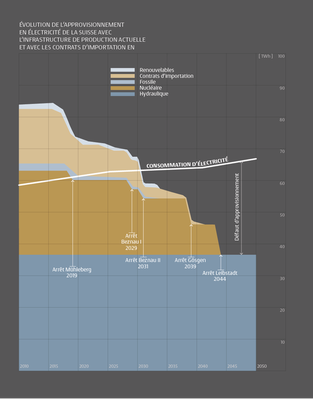What are the challenges of the Swiss energy transition?
The challenges are of several kinds: strategic (maintaining a high level of security of supply, not only for electricity in the absence of nuclear power plants but also for fuels and combustibles), socio-economic (keeping energy prices affordable for all), environmental(minimising the impact on nature and the landscape) and climatic (reducing our greenhouse gas emissions). Moreover, we must act quickly.
First, most of our electricity import contracts with France, which represent 12 TWh/year, expire between 2018 and 2035. These expiries coincide with the decommissioning of our first nuclear power plants [→ Q16]. In 2018, net electricity imports from France amounted to about 11 TWh over the year. Without new sources of supply, we would therefore run the risk of an electricity shortfall from around 2020 if our nuclear power plants were all shut down after 50 years of operation. This shortage would be postponed to about 2030 if they were operated until their 60th year [→ see figure below]. However, the Mühleberg nuclear power plant was shut down at the end of 2019 after 47 years of operation.
Second, Switzerland is also committed to reducing its greenhouse gas emissions. Since nuclear power plants do not emit CO2 directly [→ Q17], we must therefore be able to replace our nuclear electricity without jeopardising our efforts to reduce CO2 emissions.
Switzerland wishes to improve its level of energy self-sufficiency and security of supply [→ Q20] and [→ Q23], while maintaining its industrial competitiveness. From this perspective, it is obviously undesirable to increase our dependence on imported electricity from abroad to replace our domestic nuclear power, provided this remains possible in the long term.
Furthermore, as the debate on wind turbines shows, the public want solutions that replace our nuclear power plants with other energy sources that do not have significant impacts on our environment or landscapes.
Technical solutions exist, but it will be very complicated to meet all these sometimes contradictory criteria together. Despite their divergent views, the various interest groups and political parties will have to find compromises on the priorities and weightings to be given to the different criteria in question.
So it is crucial to decide on our energy strategy in as short a time as possible. Replacing the production of five nuclear reactors while reducing our dependence on fossil fuels will not happen overnight. The longer we take to decide on the way forward, the fewer options we will have to choose from.

References
- Püttgen, Hans B. (2010)
- Püttgen, Hans B. (2010). La Suisse électrique du futur - Plaque tournante électrique au coeur de l’Europe ou réduit national isolé dans ses montagnes et vallées?. Bulletin SEV/VSE, 101(9). 72.
- SwissElectric (2007)
- SwissElectric (2007). Communiqué de presse - Avenir de l’approvisionnement en électricité de la Suisse - la stratégie des investisseurs.